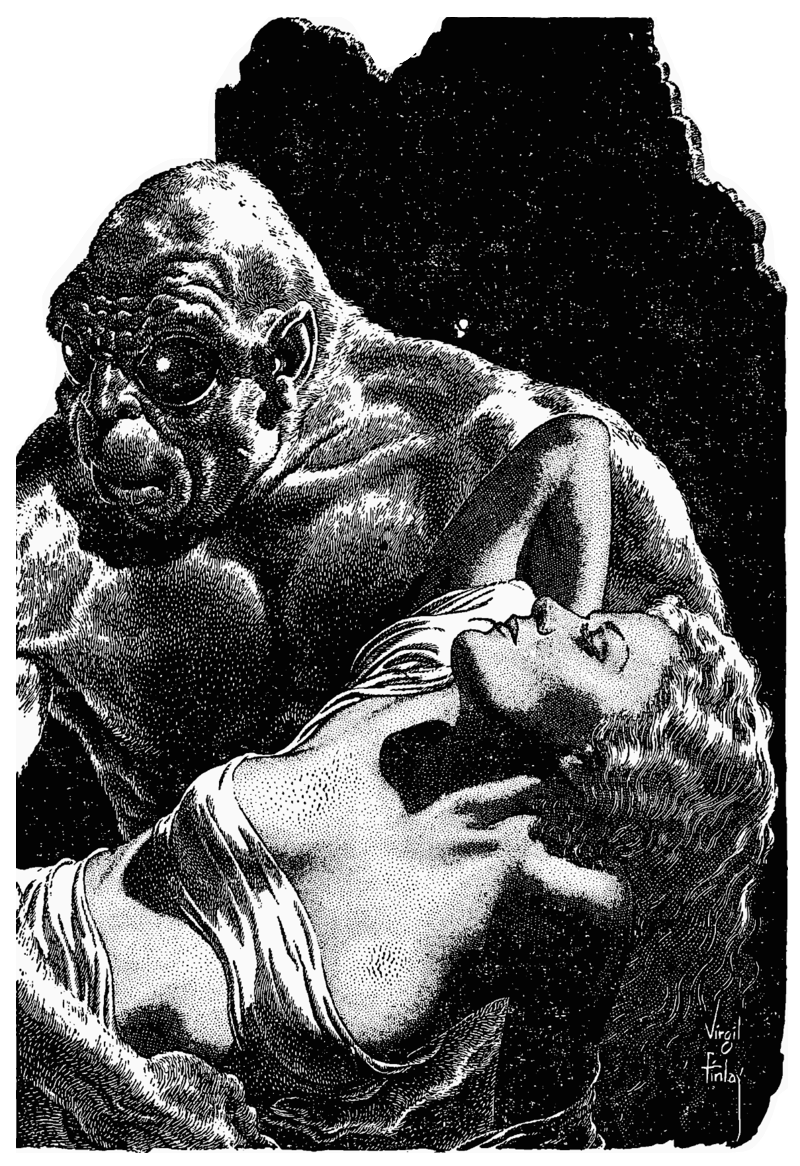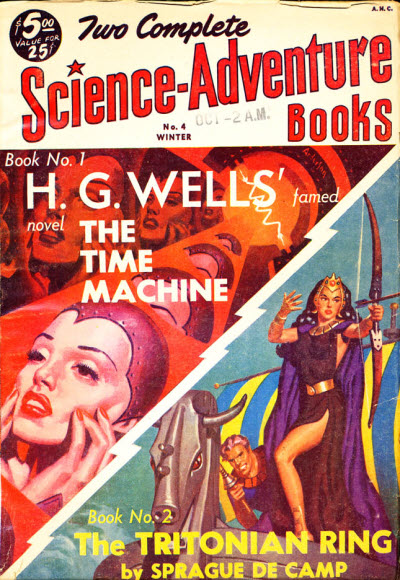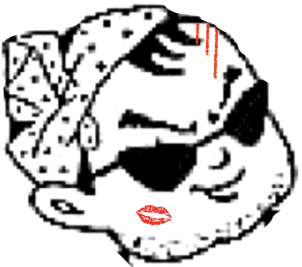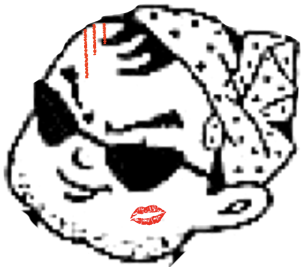

ポストヒューマン
Posthuman


A
Morlock carrying an Eloi, two fictional posthuman species in The Time
Machine
☆ ポストヒューマンとは、SF、未来学、現代アート、哲学の分野で生まれた概念で、人間を超えた状態に存在する人格や存在を意味する[1]。この概念は、倫 理や正義、言語や種を超えたコミュニケーション、社会システム、学際性の知的願望など、様々な問題に取り組むことを目的としている。 ポストヒューマニズムは、トランスヒューマニズム(バイオテクノロジーによる人間の強化)や、ポストヒューマンを物質性の超越とする狭義の定義と混同して はならない。
| Posthuman or
post-human is a concept originating in the fields of science
fiction,
futurology, contemporary art, and philosophy that means a person or
entity that exists in a state beyond being human.[1] The concept aims
at addressing a variety of questions, including ethics and justice,
language and trans-species communication, social systems, and the
intellectual aspirations of interdisciplinarity. Posthumanism is not to be confused with transhumanism (the biotechnological enhancement of human beings) and narrow definitions of the posthuman as the hoped-for transcendence of materiality.[2] The notion of the posthuman comes up both in posthumanism as well as transhumanism, but it has a special meaning in each tradition. |
ポストヒューマンとは、SF、未来学、現代アート、哲学の分野で生まれ
た概念で、人間を超えた状態に存在する人格や存在を意味する[1]。この概念は、倫理や正義、言語や種を超えたコミュニケーション、社会システム、学際性
の知的願望など、様々な問題に取り組むことを目的としている。 ポストヒューマニズムは、トランスヒューマニズム(バイオテクノロジーによる人間の強化)や、ポストヒューマンを物質性の超越とする狭義の定義と混同して はならない。 |
| Posthumanism Main article: Posthumanism In critical theory, the posthuman is a speculative being that represents or seeks to re-conceive the human. It is the object of posthumanist criticism, which critically questions humanism, a branch of humanist philosophy which claims that human nature is a universal state from which the human being emerges; human nature is autonomous, rational, capable of free will, and unified in itself as the apex of existence. Thus, the posthuman position recognizes imperfectability and disunity within oneself, and understands the world through heterogeneous perspectives while seeking to maintain intellectual rigor and dedication to objective observations. Key to this posthuman practice is the ability to fluidly change perspectives and manifest oneself through different identities. The posthuman, for critical theorists of the subject, has an emergent ontology rather than a stable one; in other words, the posthuman is not a singular, defined individual, but rather one who can "become" or embody different identities and understand the world from multiple, heterogeneous perspectives.[3] Approaches to posthumanism are not homogeneous, and have often been very critical. The term itself is contested, with one of the foremost authors associated with posthumanism, Manuel DeLanda, decrying the term as "very silly."[4] Covering the ideas of, for example, Robert Pepperell's The Posthuman Condition, and Hayles's How We Became Posthuman under a single term is distinctly problematic due to these contradictions. The posthuman is roughly synonymous with the "cyborg" of A Cyborg Manifesto by Donna Haraway.[5][6] Haraway's conception of the cyborg is an ironic take on traditional conceptions of the cyborg that inverts the traditional trope of the cyborg whose presence questions the salient line between humans and robots. Haraway's cyborg is in many ways the "beta" version of the posthuman,[citation needed] as her cyborg theory prompted the issue to be taken up in critical theory.[7] Following Haraway, Hayles, whose work grounds much of the critical posthuman discourse, asserts that liberal humanism—which separates the mind from the body and thus portrays the body as a "shell" or vehicle for the mind—becomes increasingly complicated in the late 20th and 21st centuries because information technology puts the human body in question. Hayles maintains that we must be conscious of information technology advancements while understanding information as "disembodied," that is, something which cannot fundamentally replace the human body but can only be incorporated into it and human life practices.[8] |
ポストヒューマニズム 主な記事 ポストヒューマニズム 批評理論においてポストヒューマンとは、人間を表象する、あるいは人間を再認識しようとする思弁的な存在である。ポスト・ヒューマニズム批評の対象であ り、ヒューマニズムを批判的に問うものである。ヒューマニズム哲学の一派は、人間の本性は普遍的な状態であり、そこから人間が出現すると主張し、人間の本 性は自律的で、理性的で、自由意志が可能で、存在の頂点としてそれ自体で統一されているとする。したがって、ポスト・ヒューマンの立場は、自分自身の中に 不完全性と不統一性を認め、知的厳密さと客観的観察への献身を維持しようとしながら、異質な視点を通して世界を理解する。このポストヒューマンの実践の鍵 は、視点を流動的に変化させ、異なるアイデンティティを通して自己を顕在化させる能力である。つまり、ポスト・ヒューマンとは単一の定義された個人ではな く、むしろ異なるアイデンティティに「なる」ことができる、あるいはそれを体現することができる人であり、複数の異質な視点から世界を理解することができ る人なのである[3]。 ポストヒューマニズムへのアプローチは一様ではなく、しばしば非常に批判的である。例えば、ロバート・ペペレルの『ポストヒューマンの条件』やヘイルズの 『私たちはいかにしてポストヒューマンになったか』などの思想を一つの用語でカバーすることは、こうした矛盾のために明らかに問題がある。 ポストヒューマンは、ドナ・ハラウェイによる『サイボーグ宣言』の「サイボーグ」とほぼ同義である[5][6]。ハラウェイのサイボーグ概念は、従来のサ イボーグ概念を皮肉ったものであり、その存在が人間とロボットの間の顕著な境界線に疑問を投げかけるサイボーグという伝統的な図式を逆転させている。ハラ ウェイのサイボーグは、多くの意味でポスト・ヒューマンの「ベータ版」であり、彼女のサイボーグ論は批評理論においてこの問題が取り上げられるきっかけと なった[citation needed]。ハラウェイに続き、批評的なポスト・ヒューマン言説の多くを根拠づけるヘイルズは、リベラル・ヒューマニズムは精神と身体を切り離し、し たがって身体を精神の「殻」または乗り物として描くが、20世紀後半から21世紀にかけては、情報技術によって人間の身体が疑問視されるようになったた め、ますます複雑になっていると主張する。ヘイルズは、情報を「実体のないもの」、つまり根本的に人間の身体に取って代わることはできないが、その身体と 人間の生活習慣に取り込まれることしかできないものとして理解しながら、情報技術の進歩を意識しなければならないと主張している[8]。 |
| Post-posthumanism and
post-cyborg ethics The idea of post-posthumanism (post-cyborgism) has recently been introduced.[9][10][11][12][13] This body of work outlines the after-effects of long-term adaptation to cyborg technologies and their subsequent removal, e.g., what happens after 20 years of constantly wearing computer-mediating eyeglass technologies and subsequently removing them, and of long-term adaptation to virtual worlds followed by return to "reality."[14][15] and the associated post-cyborg ethics (e.g. the ethics of forced removal of cyborg technologies by authorities, etc.).[16] Posthuman political and natural rights have been framed on a spectrum with animal rights and human rights.[17] Posthumanism broadens the scope of what it means to be a valued life form and to be treated as such (in contrast to certain life forms being seen as less-than and being taken advantage of or killed off); it “calls for a more inclusive definition of life, and a greater moral-ethical response, and responsibility, to non-human life forms in the age of species blurring and species mixing. … [I]t interrogates the hierarchic ordering—and subsequently exploitation and even eradication—of life forms.”[18] |
ポスト・ポストヒューマニズムとポスト・サイボーグ倫理 ポスト・ポストヒューマニズム(ポスト・サイボーグズム)という考え方が最近導入された[9][10][11][12][13]。この一連の研究は、サイ ボーグ技術への長期的な適応とその後の除去の後遺症について概説している、 例えば、コンピュータを媒介する眼鏡技術を20年間常時装着し、その後それを外した後に起こること、仮想世界への長期的な適応とそれに続く「現実」への帰 還[14][15]、そして関連するサイボーグ後の倫理(例えば、当局によるサイボーグ技術の強制撤去の倫理など)について概説している[16]。 ポストヒューマニズムは、価値ある生命体であり、そのように扱われることが何を意味するのか(特定の生命体が劣った存在とみなされ、利用されたり、抹殺さ れたりするのとは対照的である)の範囲を広げるものであり、「種が曖昧になり、種が混血の時代において、生命のより包括的な定義と、人間以外の生命体に対 するより大きな道徳的・倫理的対応、そして責任を求めるものである。...[中略]生命体の階層的な秩序、ひいては搾取や根絶さえも問い直す」[18]。 |
| Hybrid Interfaces: Supersenses,
Cyborg Systems, and Hybrid Bodies Technology integrated into the human body changes how individuals interact with the external world. Sensory activity is mediated by technology, creating a new interface with the world. The introduction of nanotechnologies and hybrid computing into the organism alters the normal perception and cognition of things and the world. The fusion of the human body with technology within the organism lays the groundwork for the emergence of individuals endowed with new attributes and capabilities. Human beings and the modification of their psycho-physical characteristics become subjects of direct manipulation, necessitating a reevaluation of the concept of humanity from various humanistic, philosophical, and biological perspectives. Human ability to incorporate inorganic elements of technological nature into oneself can radically alter both inner and outer appearance, transforming individuals into cyborgs. This new hybrid form replaces the humanistic view of humanity and raises a series of new philosophical questions concerning ethics and human nature.[19] Especially for new generations, the combination of carnal body and virtual body can determine forms of identity hybridization and possible negative effects on identity formation.[20] |
ハイブリッド・インターフェイス:
スーパー感覚、サイボーグ・システム、ハイブリッド・ボディ 人体に組み込まれたテクノロジーは、個人と外界との関わり方を変える。感覚活動はテクノロジーによって媒介され、世界との新たなインターフェイスを生み出 す。ナノテクノロジーやハイブリッドコンピューティングの生体への導入は、物事や世界に対する通常の知覚や認識を変化させる。人間の身体と生物内のテクノ ロジーとの融合は、新たな属性と能力に恵まれた個体の出現の基礎を築く。人間とその精神的・物理的特性の改変は、直接的な操作の対象となり、人間性という 概念を、人文学的、哲学的、生物学的なさまざまな観点から再評価する必要がある。 技術的性質の無機的要素を自分に取り込む人間の能力は、内面も外見も根本的に変化させ、個人をサイボーグへと変貌させる。この新しいハイブリッドな形態 は、人文主義的な人間観に取って代わり、倫理と人間の本性に関する一連の新しい哲学的問題を提起する[19]。 特に新しい世代にとっては、肉体とヴァーチャル・ボディの組み合わせがアイデンティティのハイブリッド化の形態を決定し、アイデンティティの形成に悪影響 を及ぼす可能性がある[20]。 |
| Transhumanism Main article: Transhumanism Definition Further information on an intermediate form between human and posthuman: Transhuman According to transhumanist thinkers, a posthuman is a hypothetical future being "whose basic capacities so radically exceed those of present humans as to be no longer unambiguously human by our current standards."[21] Posthumans primarily focus on cybernetics, the posthuman consequent and the relationship to digital technology. Steve Nichols published the Posthuman Movement manifesto in 1988. His early evolutionary theory of mind (MVT) allows development of sentient E1 brains. The emphasis is on systems. Transhumanism does not focus on either of these. Instead, transhumanism focuses on the modification of the human species via any kind of emerging science, including genetic engineering, digital technology, and bioengineering.[22] Transhumanism is sometimes criticized for not adequately addressing the scope of posthumanism and its concerns for the evolution of humanism.[23] |
トランスヒューマニズム 主な記事 トランスヒューマニズム 定義 人間とポストヒューマンの中間形態に関する詳細情報:トランスヒューマン トランスヒューマニズムの思想家によれば、ポストヒューマンとは「基本的な能力が現在の人間のそれを根本的に超えており、現在の基準ではもはや人間である ことが明確でない」[21]仮想的な未来の存在である。ポストヒューマンは主にサイバネティクス、ポストヒューマンの帰結、デジタル技術との関係に焦点を 当てている。スティーブ・ニコルズは1988年にポストヒューマン運動のマニフェストを発表した。彼の初期の心の進化理論(MVT)は、感覚を持つE1脳 の開発を可能にしている。システムに重点を置いている。トランスヒューマニズムはこのどちらにも重点を置いていない。その代わりに、トランスヒューマニズ ムは、遺伝子工学、デジタル技術、生物工学を含むあらゆる種類の新興科学による人間種の改変に焦点を当てている[22]。トランスヒューマニズムは、ポス トヒューマニズムの範囲とヒューマニズムの進化に対する懸念に適切に対処していないとして批判されることもある[23]。 |
| Methods Further information: Human enhancement Posthumans could be completely synthetic artificial intelligences, or a symbiosis of human and artificial intelligence, or uploaded consciousnesses, or the result of making many smaller but cumulatively profound technological augmentations to a biological human, i.e. a cyborg. Some examples of the latter are redesigning the human organism using advanced nanotechnology or radical enhancement using some combination of technologies such as genetic engineering, psychopharmacology, life extension therapies, neural interfaces, advanced information management tools, memory enhancing drugs, wearable or implanted computers, and cognitive techniques.[21] |
方法 さらに詳しい情報 人間強化 ポストヒューマンは、完全に合成された人工知能であったり、人間と人工知能の共生であったり、アップロードされた意識であったり、あるいは生物学的な人 間、つまりサイボーグに対して、より小さいが累積的に重大な技術的拡張を多数行った結果であったりする。後者の例としては、遺伝子工学、精神薬理学、延命 治療、神経インターフェイス、高度な情報管理ツール、記憶強化薬、ウェアラブルコンピュータや埋め込み型コンピュータ、認知技術などの技術を組み合わせ て、高度なナノテクノロジーを使って人間の生体を再設計したり、根本的に強化したりすることが挙げられる[21]。 |
| Posthuman future As used in this article, "posthuman" does not necessarily refer to a conjectured future where humans are extinct or otherwise absent from the Earth.[24] Kevin Warwick says that both humans and posthumans will continue to exist but the latter will predominate in society over the former because of their abilities.[25] Recently, scholars have begun to speculate that posthumanism provides an alternative analysis of apocalyptic cinema and fiction,[26] often casting vampires, werewolves, zombies and greys[27][28] as potential evolutions of the human form and being.[29] With these potential evolutions of humans and posthumans, human centered designed ways of thinking needs to also be inclusive of these new posthumans. The new "post human resists binary categories and, instead, integrates the human and the nonhuman.[2]" Human centered thinking needs to be redone in a way to include posthumanism. Many science fiction authors, such as Greg Egan, H. G. Wells, Isaac Asimov, Bruce Sterling, Frederik Pohl, Greg Bear, Charles Stross, Neal Asher, Ken MacLeod, Peter F. Hamilton, Ann Leckie, and authors of the Orion's Arm Universe,[30] have written works set in posthuman futures. |
ポストヒューマンの未来 ケヴィン・ワーウィックは、人間とポストヒューマンの両方が存在し続けるが、後者はその能力ゆえに前者よりも社会で優位に立つだろうと述べている [24]。[最近では、ポストヒューマニズムは終末論的な映画やフィクションの代替的な分析を提供するものであり[26]、しばしば吸血鬼、狼男、ゾン ビ、グレイ[27][28]を人間の形態や存在の潜在的な進化として配役している[29]と、学者たちは推測し始めている。新しい「ポスト・ヒューマン」 は二元的なカテゴリーに抵抗し、その代わりに人間と非人間を統合する[2]。人間中心の思考は、ポストヒューマニズムを含む形で作り直される必要がある。 グレッグ・イーガン、H・G・ウェルズ、アイザック・アシモフ、ブルース・スターリング、フレデリック・ポール、グレッグ・ベア、チャールズ・ストロス、 ニール・アッシャー、ケン・マクロード、ピーター・F・ハミルトン、アン・レッキー、オリオンズ・アーム・ユニバースの作家など、多くのSF作家がポスト ヒューマンの未来を舞台にした作品を書いている[30]。 |
| Posthuman god A variation on the posthuman theme is the notion of a "posthuman god"; the idea that posthumans, being no longer confined to the parameters of human nature, might grow physically and mentally so powerful as to appear possibly god-like by present-day human standards.[21] This notion should not be interpreted as being related to the idea portrayed in some science fiction that a sufficiently advanced species may "ascend" to a higher plane of existence—rather, it merely means that some posthuman beings may become so exceedingly intelligent and technologically sophisticated that their behaviour would not possibly be comprehensible to modern humans, purely by reason of their limited intelligence and imagination.[31] |
ポストヒューマンの神 ポストヒューマンというテーマのバリエーションとして、「ポストヒューマン・ゴッド」という考え方がある。ポストヒューマンは、もはや人間性のパラメー ターにとらわれることなく、肉体的にも精神的にも成長し、現在の人間の基準からすると神のように見えるかもしれないという考え方である。[この考え方は、 SFで描かれるような、十分に進化した種がより高次の存在次元に「昇る」可能性があるという考え方に関連していると解釈されるべきではない。むしろ、ポス ト・ヒューマンの中には、知能と想像力が限られているという純粋な理由だけで、その行動が現代人には理解できないほど、非常に知的で技術的に洗練された存 在になる可能性があるということを意味しているにすぎない[31]。 |
| Body hacking Biopunk Kardashev scale Nanopunk Posthumanization Postcyberpunk Speculative evolution Technological singularity Transhumanism Web life |
ボディハッキング バイオパンク カルダシェフ・スケール ナノパンク ポスト・ヒューマニゼーション ポストサイバーパンク 投機的進化 技術的特異点 トランスヒューマニズム ウェブライフ |
| In 2017, Penn State University
Press in cooperation with Stefan Lorenz Sorgner and James Hughes
established the Journal of Posthuman Studies, in which all aspects of
the concept "posthuman" can be analysed.[32] |
2017年、ペンシルベニア州立大学出版局は、ステファン・ローレン
ツ・ソルグナーと
ジェームズ・ヒューズと共同で、「ポストヒューマン」という概念のあらゆる側面を分析できる『ポストヒューマン研究ジャーナル』(Journal of
Posthuman Studies)を設立した[32]。 |
| References "posthumanism". Oxford Dictionary. Archived from the original on November 8, 2017. Retrieved 8 November 2017. Ferrando, Francesca "The Body" in Post- and Transhumanism: an Introduction. Peter Lang, Frankfurt: 2014. Haraway, Donna J, "Situated Knowledges" in Simians, Cyborgs, and Women. Routledge, New York: 1991 "CTheory.net". www.ctheory.net. Archived from the original on 2015-09-23. Retrieved 2009-01-16. Mateos-Aparicio, Ángel (2007). "Trespassers of Body Boundaries: The Cyborg and the Construction of a Postgendered Posthuman Identity". Critical Approaches to Ethnic American Literature (2): 243–296, 298–299. doi:10.1163/9789401204774_014. ISBN 978-94-012-0477-4. Retrieved 6 May 2024. Haraway, Donna (1985). "Manifesto for cyborgs: science, technology, and socialist feminism in the 1980s". Socialist Review: 65–108. Haraway, Donna J, Simians, Cyborgs, and Women. Routledge, New York: 1991. "A Cyborg Manifesto" originally appeared in Socialist Review in 1985. Hayles, N. Katherine (1999). How We Became Posthuman: Virtual Bodies in Cybernetics, Literature, and Informatics. University Of Chicago Press. ISBN 978-0-226-32146-2. Mann, Steve. "The post-cyborg path to deconism." CTheory (2003): 2-18. Bredenoord, Annelien L., Rieke van der Graaf, and Johannes JM van Delden. "Toward a "Post-Posthuman Dignity Area" in Evaluating Emerging Enhancement Technologies." The American Journal of Bioethics 10, no. 7 (2010): 55-57. Mann, Steve, James Fung, Mark Federman, and Gianluca Baccanico. "Panopdecon: deconstructing, decontaminating, and decontextualizing panopticism in the postcyborg era." Surveillance & Society 1, no. 3 (2002): 375-398. Campbell, Heidi A. "Postcyborg Ethics: A New Way to Speak of Technology." Explorations in Media Ecology 5, no. 4 (2006): 279-296. Spiller, Neil. "The Magical Architecture in Drawing Drawings." Journal of Architectural Education 67, no. 2 (2013): 264-269. Mann, Steve. "'WearCam'(The wearable camera): personal imaging systems for long-term use in wearable tetherless computer-mediated reality and personal photo/videographic memory prosthesis." In Wearable Computers, 1998. Digest of Papers. Second International Symposium on, pp. 124-131. IEEE, 1998. Azuma, Ronald, Yohan Baillot, Reinhold Behringer, Steven Feiner, Simon Julier, and Blair MacIntyre. "Recent advances in augmented reality[dead link]." IEEE computer graphics and applications 21, no. 6 (2001): 34-47. Muri, Allison. The Enlightenment cyborg: a history of communications and control in the human machine, 1660-1830. University of Toronto Press, 2007. Woody Evans, 2015. "Posthuman Rights: Dimensions of Transhuman Worlds". Revista Teknokultura 12(2). [1] Nayar, Pramod K. (2014). Posthumanism. Cambridge: Polity. pp. 8–9. ISBN 978-0745662411. Eugenio Viola. Post Human: experiences and issues in art criticism. Digennaro, Simone (April 4, 2024). "The syndrome of multiple bodies: the transformative impact of the onlife existence on preadolescents". Frontiers in Education. 9. doi:10.3389/feduc.2024.1362448. "Transhumanist FAQ". Humanity+. Version 3.0. c. 2016 [Version 1.0 published c. 1998]. Archived (PDF) from the original on 2006-12-31. Retrieved 2018-08-13. LaGrandeur, Kevin (2014-07-28). "What is the difference between posthumanism and transhumanism?". Institute for Ethics and Transforming Technologies. Retrieved 8 November 2017. Evans, W. (June 2022). "Review of On Transhumanism". Prometheus: Critical Studies in Innovation. 38 (2): 271–74. doi:10.13169/prometheus.38.2.0271. Ferrando, Francesca "Space Migration Must Be Posthuman" in Critical Posthumanism and Planetary Futures, Springer 2016, pp. 243-256. Warwick, Kevin (2004). I, Cyborg. University of Illinois Press. Borg, Ruben (2019). Fantasies of Self-Mourning: Modernism, the Posthuman and the Finite. Leiden: Brill. ISBN 9789004390348. Masters, Michael Paul (March 15, 2019). Identified Flying Objects A Multidisciplinary Scientific Approach to the UFO Phenomenon. Masters Creative LLC. pp. 168–213. ISBN 9781733634007. Masters, Dr Michael Paul (June 2022). The Extratempestrial Model. Full Circle Press. pp. 273–286. ISBN 978-1733634045. Deborah Christie, Sarah Juliet Lauro, ed. (2011). Better Off Dead: The Evolution of the Zombie as Post-Human. Fordham Univ Press. p. 169. ISBN 0-8232-3447-9, 9780823234479 "Archailects". Orion's Arm - Encyclopedia Galactica. Michael Shermer. Shermer's Last Law, Jan 2002, see also * Oliver Krüger: Virtual Immortality. God, Evolution, and the Singularity in Post- and Transhumanism., Bielefeld: transcript 2021 "Journal of Posthuman Studies: Philosophy, Technology, Media". |
参考文献 「ポストヒューマニズム"。オックスフォード辞書. 2017年11月8日に原文からアーカイブされた。2017年11月8日取得。 Ferrando, Francesca 「The Body」 in Post- and Transhumanism: an Introduction. Peter Lang, Frankfurt: 2014. Haraway, Donna J, 「Situated Knowledges」 in Simians, Cyborgs, and Women. Routledge, New York: 1991 「CTheory.net」. www.ctheory.net. Archived from the original on 2015-09-23. Retrieved 2009-01-16. Mateos-Aparicio, Ángel (2007). "身体の境界の侵入者: サイボーグとポストジェンダー的ポストヒューマン・アイデンティティの構築". Critical Approaches to Ethnic American Literature (2): doi:10.1163/9789401204774_014. ISBN 978-94-012-0477-4. 2024年5月6日取得。 Haraway, Donna (1985). 「サイボーグ宣言:1980年代の科学、テクノロジー、社会主義フェミニズム". Socialist Review: 65-108. Haraway, Donna J, Simians, Cyborgs, and Women. Routledge, New York: 1991. 「サイボーグ宣言」は1985年にSocialist Reviewに掲載された。 Hayles, N. Katherine (1999). How We Became Posthuman: Cybernetics, Literature, and Informatics. University Of Chicago Press. ISBN 978-0-226-32146-2. Mann, Steve. 「The post-cyborg path to deconism.」. CTheory (2003): 2-18. Bredenoord, Annelien L., Rieke van der Graaf, and Johannes JM van Delden. 「Toward a 」Post-Posthuman Dignity Area「 in Evaluating Emerging Enhancement Technologies」. The American Journal of Bioethics 10, no. 7 (2010): 55-57. Mann, Steve, James Fung, Mark Federman, and Gianluca Baccanico. 「Panopdecon: deconstructing, decontaminating, and decontextualizing panopticism in the postcyborg era.」. Surveillance & Society 1, no. 3 (2002): 375-398. Campbell, Heidi A. "Postcyborg Ethics: テクノロジーを語る新しい方法". Explorations in Media Ecology 5, no. 4 (2006): 279-296. Spiller, Neil. 「The Magical Architecture in Drawing Drawings.」. Journal of Architectural Education 67, no. 2 (2013): 264-269. Mann, Steve. 「『WearCam』(The wearable camera): ウェアラブル・テザーレス・コンピュータ・メディアド・リアリティと個人用写真/ビデオグラフィ・メモリー・プロテーゼにおける長期使用のための人格画像 システム」. Wearable Computers, 1998. 論文ダイジェスト。Second International Symposium on, pp.124-131. IEEE, 1998. Azuma, Ronald, Yohan Baillot, Reinhold Behringer, Steven Feiner, Simon Julier, and Blair MacIntyre. 「Recent advances in augmented reality[dead link].」. IEEE computer graphics and applications 21, no. 6 (2001): 34-47. Muri, Allison. The Enlightenment cyborg: a history of communications and control in the human machine, 1660-1830. University of Toronto Press, 2007. Woody Evans, 2015. "ポストヒューマンの権利: トランスヒューマンワールドの次元". Revista Teknokultura 12(2). [1] Nayar, Pramod K. (2014). Posthumanism. ケンブリッジ: Polity. ISBN 978-0745662411. エウジェニオ・ヴィオラ. ポスト・ヒューマン:美術批評における経験と課題. Digennaro, Simone (April 4, 2024). 「複数の身体の症候群:前青少年におけるオンライフ存在の変容的影響」. 教育のフロンティア。9. doi:10.3389/feduc.2024.1362448. 「トランスヒューマニストFAQ」. Humanity+. Version 3.0. c. 2016 [Version 1.0 published c. 1998]. Archived (PDF) from the original on 2006-12-31. 2018-08-13を取得した。 LaGrandeur, Kevin (2014-07-28). 「ポストヒューマニズムとトランスヒューマニズムの違いは何か?」. Institute for Ethics and Transforming Technologies. 2017年11月8日取得。 Evans, W. (June 2022). 「Review of On Transhumanism」. Prometheus: Critical Studies in Innovation. 38 (2): 271–74. doi:10.13169/prometheus.38.2.0271. Ferrando, Francesca 「Space Migration Must Be Posthuman」 in Critical Posthumanism and Planetary Futures, Springer 2016, pp.243-256. Warwick, Kevin (2004). I, Cyborg. University of Illinois Press. Borg, Ruben (2019). Fantasies of Self-Mourning: Modernism, the Posthuman and the Finite. Leiden: Brill. ISBN 9789004390348. Masters, Michael Paul (March 15, 2019). Identified Flying Objects A Multidisciplinary Scientific Approach to the UFO Phenomenon. Masters Creative LLC. 168-213頁。ISBN 9781733634007. Masters, Dr Michael Paul (June 2022). 地球外モデル. フルサークル・プレス. ISBN 978-1733634045. Deborah Christie, Sarah Juliet Lauro, ed. (2011). Better Off Dead: The Evolution of the Zombie as Post-Human. Fordham Univ Press. p. 169. ISBN 0-8232-3447-9, 9780823234479 「アルカイレクト」. オリオンの腕 - エンサイクロペディア・ギャラクティカ. マイケル・シャーマー Shermer's Last Law, Jan 2002, 参照 * Oliver Krüger: 仮想不死。ポストヒューマニズムとトランスヒューマニズムにおける神、進化、特異点。 「ポストヒューマン研究誌: 哲学、テクノロジー、メディア |
| https://en.wikipedia.org/wiki/Posthuman |
|
リ ンク
文 献
そ の他の情報
Copyleft, CC, Mitzub'ixi Quq Chi'j, 1996-2099

Copyleft, CC, Mitzub'ixi Quq Chi'j, 1996-2099
☆
 ☆
☆